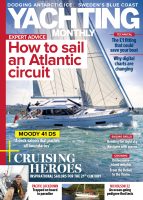Mooring a boat can be nerve-racking – especially when there’s an audience gathered outside the marina bar, watching with keen interest, writes Susannah Hart
Whether you’re a seasoned sailor or a novice skipper, manoeuvring in tight spaces can be challenging. But with the right equipment, returning to your berth doesn’t have to be stressful. We spoke with Paul Hardy, Refit & Service Manager at Ancasta Yacht Services, to explore how bow thrusters and stern thrusters can transform the berthing experience – making it smoother, easier, and far less daunting.
Thrusters are auxiliary propulsion devices designed to enhance a yacht’s manoeuvrability, whether it’s a monohull or multihull, a compact cruiser or a luxury yacht. Available in various types, each with its own advantages, thrusters help boaters move sideways, counteract wind or current, and moor with precision. Let’s take a closer look at the different options available.
Tunnel thrusters
Tunnel thrusters are one of the most common types used on yachts and motorboats. Installed within a tunnel across the bow, these thrusters use one or two propellers to push water to one side, creating lateral thrust.
Their reliability, effectiveness in most conditions, and affordability make tunnel thrusters a popular choice. Available in various sizes, they provide excellent control and are relatively easy to install and maintain. However, since they are permanently fixed in the hull, they create drag, which can affect speed and fuel efficiency.

Tunnel thrusters are reliable and affordable, but can create drag
Installation also requires significant hull modifications, and the tunnel itself takes up space inside the boat. Also, tunnel thrusters can be noisy, particularly at higher speeds. Despite these trade-offs, their performance and cost-effectiveness make them a favourite with boat owners.
Retractable thrusters
For those looking to minimise drag and improve fuel efficiency, retractable thrusters offer an excellent alternative. Mounted within the hull, these thrusters deploy only when needed and retract into a dedicated compartment when not in use.
Particularly well-suited for sailing boats and performance-oriented motorboats, retractable thrusters eliminate additional water resistance while providing powerful lateral thrust. Their ability to be positioned optimally enhances efficiency without compromising speed or handling. However, these benefits come at a higher cost.
Retractable thrusters are more complex and expensive than tunnel thrusters, requiring precise integration into the hull to ensure the hinged door sits completely flush. The lifting mechanism requires additional maintenance to ensure long-term reliability. Still, for those who prioritise speed and whose hull form is suitable, retractable thrusters are an investment worth considering.

Typical layout of a jet thruster system
Jet thrusters
This kind of thruster takes a different approach, using a water pump system to draw in and expel water through nozzles to generate thrust. Because they lack external moving parts, they are a safer, more durable option and create minimal drag as their 2in (50mm) nozzles sit flush with the hull. They can be fitted in the bow, stern or amidships, offering flexibility in vessel design.
One of the biggest advantages of jet thrusters is their quiet operation, making them ideal for sailors who value a low-noise experience. Jet thrusters’ compact design allows installation closer to the waterline without sacrificing performance, offering superior flexibility for shallow bow sections.
Additionally, they require less maintenance since there are no exposed propellers or mechanical components that can be damaged by debris.
Article continues below…
Some examples where jet thrusters have a real advantage are traditional timber hulls – from historic sailing boats to elegant mahogany motor yachts, preserving their classic charm while adding modern control; and steel or aluminium hulled vessels – as the simple installation of the nozzles reduces the need for extensive cutting and welding.
When requesting an estimate, it’s important to factor in the labour costs and not just compare the materials costs. Jet thrusters are designed with the competent DIY enthusiast in mind, so potentially are
a do-it-yourself project thereby reducing costs. They require a dedicated pump and plumbing system, but once installed they provide precise control and their modern design and reliability make them a good choice for stress-free manoeuvring.

A stern thruster working with a bow thruster provides complete control over your boat’s positioning
Stern thrusters
Stern thrusters work in exactly the same way as bow thrusters, offering additional lateral thrust for improved control. They are particularly beneficial for larger boats, single-engine vessels prone to prop walk, or yachts with significant windage, making close-quarters manoeuvring – especially when reversing or mooring – far easier.
When paired with a bow thruster, stern thrusters provide complete control over a boat’s positioning, ensuring precise movement in marinas or other confined spaces – although, depending on hull form, a different type of thruster may be required from the bow area.
However, stern thrusters have some downsides. If externally mounted, they can create drag, affecting speed and fuel efficiency but are sometimes the only option if there is limited internal space. A stern thruster combined with a bow thruster can be an excellent addition for those who regularly navigate in tight spaces or want extra confidence when berthing.

A retractable thruster will minimise drag and increase fuel efficiency
Choosing the right thruster
Selecting the right thruster for your yacht depends on several factors, so it’s important to discuss with the experts taking these into consideration:
- Boat Size & Type: It goes without saying that larger boats often require more powerful thrusters.
- Hull Design: Some hull shapes are better suited to specific thruster types.
- Budget: Thruster costs can vary widely depending on complexity and installation.
- Intended Use: Your home berth, whether frequently mooring or tight-space manoeuvring, is a very important consideration.
Conclusion
Given the complexity of thruster selection and installation, consulting a qualified marine professional is highly recommended. An expert can assess your boat’s specifications, recommend the best thruster type and size, and ensure a proper installation.
Professional guidance not only optimises performance but also prevents costly mistakes that could result from improper placement or inadequate power selection. Ultimately, the right thruster – when professionally installed – enhances safety, convenience and your overall boating experience.
So, next time you’re pulling into a marina on a sunny Sunday afternoon, you can moor with confidence, knowing that your thruster has you covered!
For more information, contact Ancasta Yacht Services
Enjoyed reading this?
A subscription to Yachting Monthly magazine costs around 40% less than the cover price, so you can save money compared to buying single issues.
Print and digital editions are available through Magazines Direct – where you can also find the latest deals.
YM is packed with information to help you get the most from your time on the water.
-
-
- Take your seamanship to the next level with tips, advice and skills from our experts
- Impartial in-depth reviews of the latest yachts and equipment
- Cruising guides to help you reach those dream destinations
-
Follow us on Facebook, Twitter and Instagram.
Note: We may earn a commission when you buy through links on our site, at no extra cost to you. This doesn’t affect our editorial independence.





